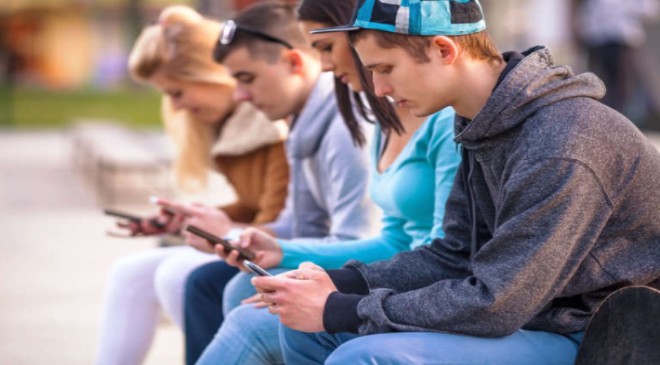Throughout the COVID-19 pandemic, Americans relied on technology to continue working, going to school, checking in with health care providers and connecting with family and friends.
But a recent study found recreational screen time for teens skyrocketed, too.
According to the study, published Monday in JAMA Pediatrics, screen time outside of virtual school among teenagers doubled from pre-pandemic estimates of 3.8 hours per day to 7.7 hours.
Kids were essentially putting in a full work day of recreational screen time,” said Dr. Michael Rich, director of the Digital Wellness Lab at Boston Children’s Hospital and associate professor of pediatrics at Harvard Medical School, who was unaffiliated with the study. “That’s a pretty crazy phenomenon when you consider they were also on screens for 5 to 7 hours a day for school.”

Using data from the Adolescent Brain Cognitive Development Study, a large, long-term study of brain development funded by the National Institutes of Health, researchers compared 5,412 participants’ screen time from 2016 to their screen time in May 2020.
In 2016, participants were between the ages of 9 and 10, said lead study author Dr. Jason Nagata, pediatrician at the University of California, San Francisco. During the pandemic, most were 12 and 13.
The most common recreational activities included watching or streaming videos, movies or television shows, multiple-player gaming or single-player gaming, the UCSF-led researchers found.
The estimates for social media were lower than watching TV and movies and that’s probably reflective of this age range,” Nagata said. “As teens get older, the social media use (likely) increases.”
Wellness experts say actual screen time may be higher than what the study results estimated, as participants were asked to self-report and may have underreported their media use.
“If anything, this is an underestimate of the time they are ‘actively using’ screens,” Rich said. “When you add in multitasking and ambient exposure … these numbers are low.”
The study also found children of color and those from lower-income families logged more hours on screens than their white, wealthier peers.
“This may be due to lack of financial resources to do other activities or lack of access to safe outdoor spaces,” Nagata said.
Researchers also looked at the amount of screen time and participants’ mental health. They found higher screen times were associated with poorer mental health and greater perceived stress, while more social support and better coping behaviors were associated with a lower total screen use.
“As screen time increased, so did adolescents’ worry and stress, while their coping abilities declined,” he said. “Though social media and video chat can foster social connection and support, we found that most of the adolescents’ screen use during the pandemic didn’t serve this purpose.”
Previous studies have linked high screen times and poor mental health, Rich said, but his work at the Digital Wellness Lab suggests it’s a “bi-directional relationship” where poor mental health leads to more screen use, which worsens mental health.
“What we’re seeing here is that the mental health issues preceded the screen use rather than the other way around,” Rich said. “Particularly when you consider the overall mental health implications of the pandemic and how anxiety and depression all spiked during the lockdown period.”
Excessive screen time has not only been linked to poor mental health, but also poor physical health.
A 2020 study, also led by Nagata and published in the International Journal of Eating Disorders, calculated a weighted average of screen use in a typical day and found each additional hour of total screen time per day was associated with 1.11 higher odds of a binge-eating disorder.
Each additional hour of social networking, texting and watching or streaming television shows or movies was also significantly associated with binge-eating disorder.
“Teens that spend a lot of time sedentary in front of a screen are more likely to overeat,” Nagata said.
Excessive screen use can also affect sleep, structured meal times, and physical activity, which are all crucial to a healthy lifestyle, said Dr. Paul Weigle, chair of the American Academy of Child & Adolescent Psychiatry media committee.
Surveys from the Digital Wellness Lab have shown parents reported children using screen media even more frequently during the summer compared to the 2020 school year. That upward trend has continued into the 2021 school year, Rich said, despite children and teens making a full return to in-person learning.
“We’re getting multiple data points and multiple studies showing a very consistent increase into using the digital environment more and more, not just for schooling and work, but for recreation, entertainment and social life,” he said.
However, experts recommend parents monitor the quality of their child’s screen time – not the quantity.
Screen time is not “inherently toxic,” Rich said. But it can become so if it starts to undercut academic performance, sleep and relationships.
“We need to be conscious of what it is displacing,” he said. “The one place where the issue of screen time comes in is what you’re not doing when you’re on a screen.”
Instead of the “old idea of a screen time limit,” Rich suggested increasing non-screen time throughout the day. This could happen at the dinner table, while doing homework, and especially during sleeping hours.
Weigle recommended adjusting children’s phone and tablet settings so they become inactive during certain times of the day and night. If children complain of being bored, Rich said, let them be bored.
“We’re not giving boredom the space it needs and boredom is where creativity and imagination happens,” he said. “We need to bring back boredom”
Follow Adrianna Rodriguez on Twitter: @AdriannaUSAT.
Health and patient safety coverage at USA TODAY is made possible in part by a grant from the Masimo Foundation for Ethics, Innovation and Competition in Healthcare. The Masimo Foundation does not provide editorial input.









































